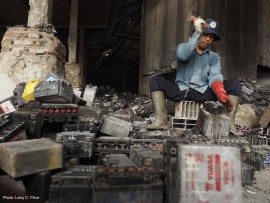Used Lead-Acid Battery Recycling
Lead-acid batteries are rechargeable batteries that are most commonly used as automotive batteries in vehicles for starting, lighting and ignition. They consist of a plastic case containing lead plates covered with a lead paste submersed in dilute sulfuric acid. Lead-acid batteries are rechargeable, but eventually the lead plate material and paste breaks down and the battery can no longer hold an electrical charge. Such used lead-acid batteries (ULAB) are classified as hazardous waste under the Basel Convention and their disposal is regulated in all OECD countries. When used lead-acid batteries are recycled properly the battery, the plastic and the metallic components are separated. The plastics are recycled and usually used to manufacture more battery cases. The used lead plates and paste material are smelted to remove any impurities and cast into lead ingots1. Lead ingots are used in the manufacture of new lead-acid batteries, thereby making a continuous closed loop system.
In LMICs, recycling of these batteries is a large industry as the lead in the batteries can be reused in various product-manufacturing processes. Countries with limited lead ore sources are eager to collect and recycle lead-acid batteries to supplement their lead resources. The rising demand for automobiles in low and middle-income countries is driving the upsurge in demand for lead2.
Battery recycling contributes to more than 150 sites in the Pure Earth database, potentially putting almost 1 million people at risk. Geographically, the largest numbers of polluted sites are in Southeast Asia, with Africa, Central and South America also contributing a substantial amount. In addition, it is known that battery recycling is also a significant industry in South Asia and China as well.
Key Pollutants
The amount of lead and the highly toxic nature of the element clearly make it the top pollutant at polluted battery recycling sites. Other pollutants include arsenic and cadmium. Lead causes a host of health problems and disproportionately affects children, causing developmental and neurological problems. Reference the health impacts of lead earlier in the report for more information.
Pure Earth found that lead exposure was the single largest risk contributing to DALYs in the 158 countries assessed. Even with the severe underestimate of the scale of the issue, the estimated DALYs from the lead-acid battery recycling range from 2 million to 4.8 million, with almost 1.9 million people at risk.
Exposure Pathways
In informal recycling processes, used lead-acid batteries are broken up using hand axes or hammers; smelting of the metallic components occurs out in the open or inside domestic homes; and the toxic waste products are disposed of into the surrounding environment untreated. In addition, some used lead-acid batteries are reconditioned by cutting them open, throwing away any defective plates and sometimes the toxic sludge that settles on the bottom of the battery, and then resealing the cases. This type of recycling also leads to the dispersion of lead into the environment.
Emissions and fugitive dusts released from the small scale melting and casting of molten lead and from waste are the main exposure pathways. When lead is melted – often in a domestic setting – the fumes condense as particulates, which can settle into the immediate surroundings and fall onto soil and waterways. Fugitive dust emissions also are deposited in the local area. Waste collected from these processes is often dumped into uncovered piles or directly into nearby waterways, and contaminants then leach into ground water and waterways used by local communities. The largest pathways of exposure in the Pure Earth’s database are ingestion of contaminated soil, particularly by children who often play in the dirt, or the ingestion of lead dust that has settled on food or inhalation of dust or emissions.
1. “Battery Recycling.” Battery Council International. Available at: http://www.batterycouncil.org/LeadAcidBatteries/BatteryRecycling/tabid/71/Default.aspx
2. “The Basel Ban And Batteries, A Teaching Case: The Basel Ban And Batteries.” Available at http://www.commercialdiplomacy.org/case_study/case_batteries.htm




